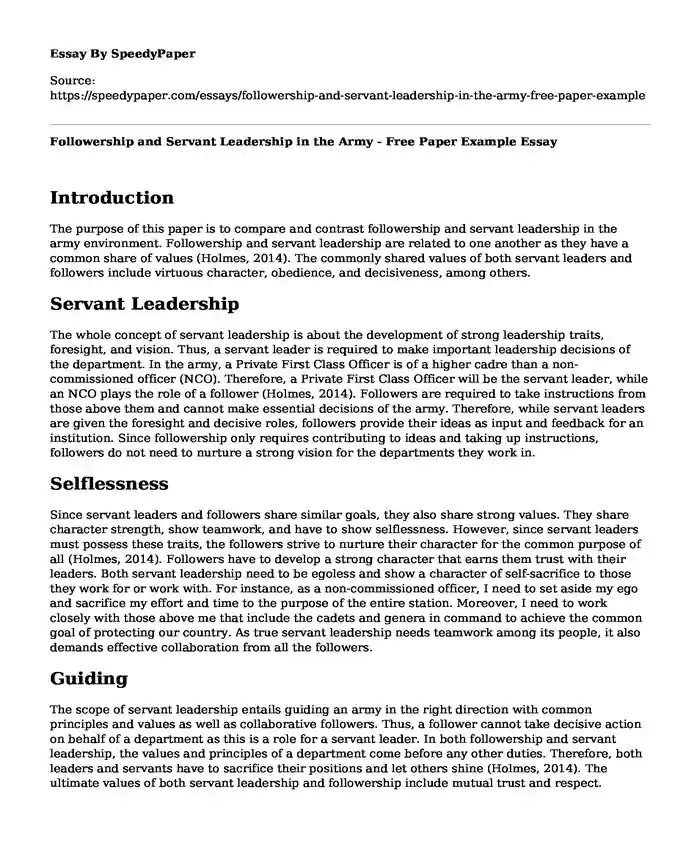
| Type of paper: | Essay |
| Categories: | Leadership analysis Army |
| Pages: | 3 |
| Wordcount: | 640 words |
Introduction
The purpose of this paper is to compare and contrast followership and servant leadership in the army environment. Followership and servant leadership are related to one another as they have a common share of values (Holmes, 2014). The commonly shared values of both servant leaders and followers include virtuous character, obedience, and decisiveness, among others.
Servant Leadership
The whole concept of servant leadership is about the development of strong leadership traits, foresight, and vision. Thus, a servant leader is required to make important leadership decisions of the department. In the army, a Private First Class Officer is of a higher cadre than a non-commissioned officer (NCO). Therefore, a Private First Class Officer will be the servant leader, while an NCO plays the role of a follower (Holmes, 2014). Followers are required to take instructions from those above them and cannot make essential decisions of the army. Therefore, while servant leaders are given the foresight and decisive roles, followers provide their ideas as input and feedback for an institution. Since followership only requires contributing to ideas and taking up instructions, followers do not need to nurture a strong vision for the departments they work in.
Selflessness
Since servant leaders and followers share similar goals, they also share strong values. They share character strength, show teamwork, and have to show selflessness. However, since servant leaders must possess these traits, the followers strive to nurture their character for the common purpose of all (Holmes, 2014). Followers have to develop a strong character that earns them trust with their leaders. Both servant leadership need to be egoless and show a character of self-sacrifice to those they work for or work with. For instance, as a non-commissioned officer, I need to set aside my ego and sacrifice my effort and time to the purpose of the entire station. Moreover, I need to work closely with those above me that include the cadets and genera in command to achieve the common goal of protecting our country. As true servant leadership needs teamwork among its people, it also demands effective collaboration from all the followers.
Guiding
The scope of servant leadership entails guiding an army in the right direction with common principles and values as well as collaborative followers. Thus, a follower cannot take decisive action on behalf of a department as this is a role for a servant leader. In both followership and servant leadership, the values and principles of a department come before any other duties. Therefore, both leaders and servants have to sacrifice their positions and let others shine (Holmes, 2014). The ultimate values of both servant leadership and followership include mutual trust and respect.
A servant leader follows the army ethics to gather ideas from soldiers that will help in developing a close working relationship. Before making an important decision, leaders have to seek the opinions of soldiers about a particular issue. Such involvement allows soldiers to entrust you, and this creates unity. Servant leadership also tests a person’s empathy skills which involves understanding the origin of a soldier’s ideas and their relevance (Holmes, 2014). If the ideas are similar to that of a leader, then the decision-making process is made easier. The main features of a servant leader include persuasion, stewardship, conceptualization, awareness, commitment, healing, and cohesion skills. On the contrary, a follower is characterized by the ability and willingness to follow a leader. In the army, a follower works under a non-commissioned officer to contribute ideas that help in certain tasks and projects.
Conclusion
Thus, both servants and leaders share similar goals that include building mutual empowerment and respect amidst each other. Therefore, servant leaders and followers are more likely to be found in similar places as they work together for a common goal.
References
Holmes, C. (2014). Army Leadership and Followership. Citizen Soldier Resource Center.
https://www.part-time-commander.com/army-leadership-and-followership/
Cite this page
Followership and Servant Leadership in the Army - Free Paper Example. (2023, Nov 10). Retrieved from https://speedypaper.com/essays/followership-and-servant-leadership-in-the-army-free-paper-example
Request Removal
If you are the original author of this essay and no longer wish to have it published on the SpeedyPaper website, please click below to request its removal:
- Free Essay on the Impacts of Leadership Style on Organizational Performance
- Free Essay on Juvenile Referral Resources
- Jefferson's Declaration of Independence and Social Contract, Essay Sample
- Free Essay: Communication, Facilitative, Collaborative, and Teamwork Skills
- Essay Sample on Branding Strategy in Marketing: Starbucks Backgrounder
- Essay Example on African Political Economy
- Essay on Navigating Overtime Compensation: A Legal Analysis Under the Fair Labor Standards Act
Popular categories




